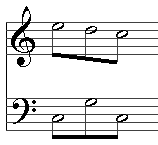
Fundamental structure
Encyclopedia

Schenkerian analysis
Schenkerian analysis is a method of musical analysis of tonal music based on the theories of Heinrich Schenker. The goal of a Schenkerian analysis is to interpret the underlying structure of a tonal work. The theory's basic tenets can be viewed as a way of defining tonality in music...
, the fundamental structure is a specific musical pattern that occurs at the most remote (or "background") level of structure. A basic elaboration of the tonic
Tonic (music)
In music, the tonic is the first scale degree of the diatonic scale and the tonal center or final resolution tone. The triad formed on the tonic note, the tonic chord, is thus the most significant chord...
triad
Triad (music)
In music and music theory, a triad is a three-note chord that can be stacked in thirds. Its members, when actually stacked in thirds, from lowest pitched tone to highest, are called:* the Root...
, it consists of the fundamental line accompanied by the bass arpeggiation. Hence the fundamental structure, like the fundamental line itself, takes one of three forms, according to which tonic triad pitch is the primary tone. The following is an example in C major
C major
C major is a musical major scale based on C, with pitches C, D, E, F, G, A, and B. Its key signature has no flats/sharps.Its relative minor is A minor, and its parallel minor is C minor....
, with the fundamental line descending from scale degree
Degree (music)
In music theory, a scale degree or scale step is the name of a particular note of a scale in relation to the tonic...
:
Fundamental line
The fundamental line is the melodic aspect of the Fundamental structure (Ursatz), "a stepwiseSteps and skips
In music, a step, or conjunct motion, is a linear or successive interval between two pitches which are consecutive scale degrees. Any larger interval is called a skip , or disjunct motion...
descent from one of the triad
Triad (music)
In music and music theory, a triad is a three-note chord that can be stacked in thirds. Its members, when actually stacked in thirds, from lowest pitched tone to highest, are called:* the Root...
notes to the tonic
Tonic (music)
In music, the tonic is the first scale degree of the diatonic scale and the tonal center or final resolution tone. The triad formed on the tonic note, the tonic chord, is thus the most significant chord...
":
--, ----, or -------
with the bass arpeggiation
Arpeggio
An arpeggio is a musical technique where notes in a chord are played or sung in sequence, one after the other, rather than ringing out simultaneously...
being the harmonic
Harmony
In music, harmony is the use of simultaneous pitches , or chords. The study of harmony involves chords and their construction and chord progressions and the principles of connection that govern them. Harmony is often said to refer to the "vertical" aspect of music, as distinguished from melodic...
aspect. (Middleton 1990, p.193)
Source
- Middleton, Richard (1990/2002). Studying Popular Music. Philadelphia: Open University Press. ISBN 0-335-15275-9.
Further reading
- Cadwallader, Allen and Gagné, David. Analysis of Tonal Music: A Schenkerian Approach. New York: Oxford University Press, 1998.
- Schenker, Heinrich. Free CompositionFree CompositionFree Composition is a treatise by Heinrich Schenker, and possibly Schenker's best known work. The third volume of New Musical Theories and Fantasies , it was first published posthumously in 1935.Free Composition aims to present a complete and systematic outline of Schenker's mature theory, relying...
. Ernst Oster, tr. and ed. New York: Longman.

